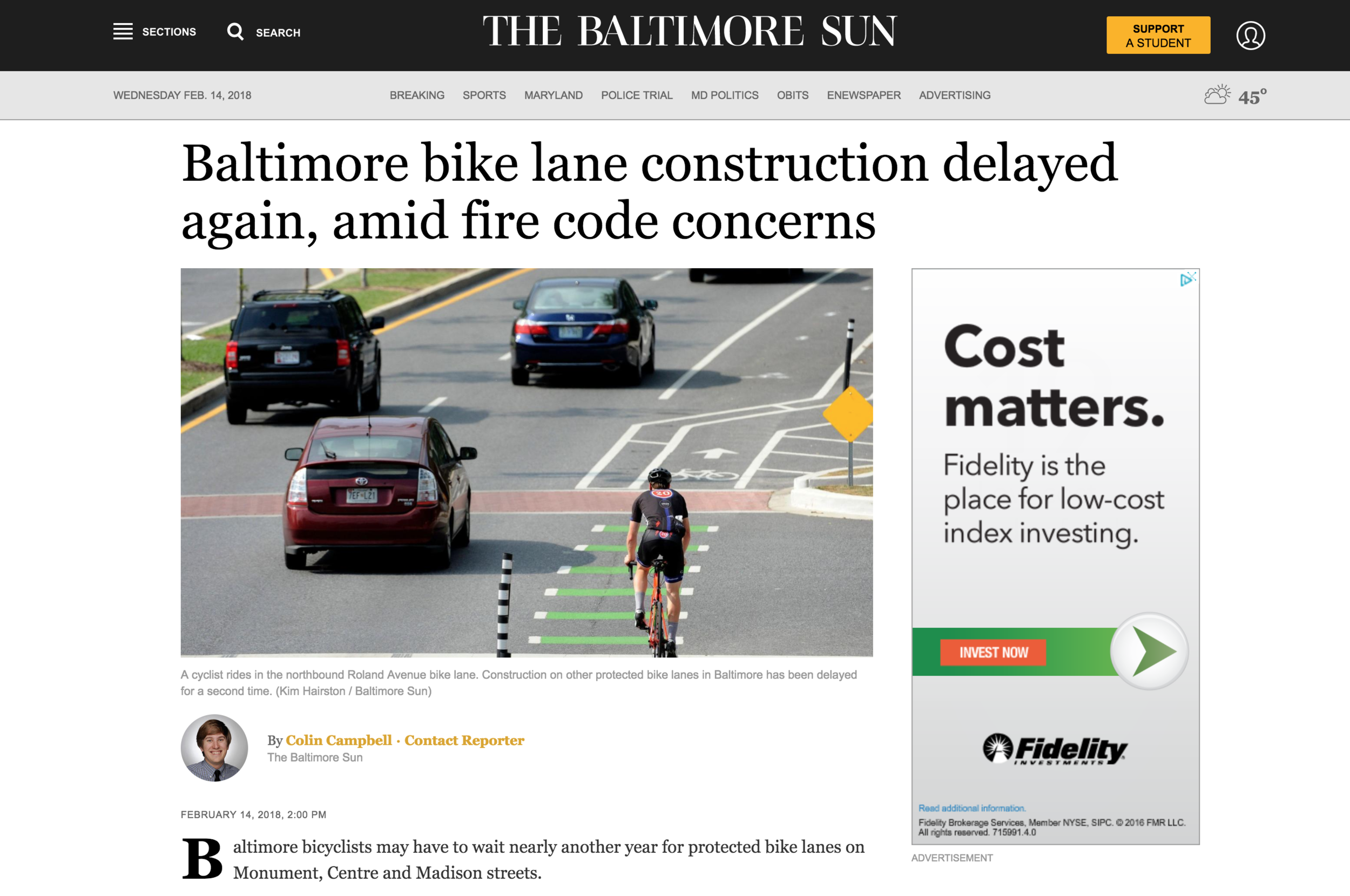Skip the background, what can I do right now?
Fill the Room. Show up and Speak out at the following meetings:
Background: Downtown Bike Network
Originally due to be installed in 2015-2016, the Downtown Bike Network included protected bike lanes on Centre Street, Madison Street, and Maryland Avenue, and standard bike lanes on Monument Street, Preston Street, and Biddle Street.
Maryland Avenue was installed, but the remainder of the network has been on a construction halt since Spring of last year due to complaints from the Baltimore City Fire Department, which is requesting 26 feet of clear street width on protected sections of the network.
It is possible to re-design an east-west, fully-separated, all-ages facility within the Baltimore City Fire Department constraints, but it would likely remove parking.
The city has extended the construction halt as long as they can, and construction must continue this Spring or we risk losing the contract and spending significant additional resources.
As a result, we support the concept of a re-design to address Baltimore City Fire Department's unreasonable constraints, but believe whatever is installed must maintain a separated, all-ages design from project limit to project limit.
Background: Maryland Avenue
Maryland Avenue looks finished. But technically, the job hasn't been closed out. There is still some paint to be laid. As a result, it is still in limbo. Baltimore City Fire Department claims it fails to meet their fire clearance requirements. On large portions of Maryland Avenue, protection would need to be removed to meet those requirements.
We oppose making changes to Maryland Avenue because it is a NACTO compliant, nationally recognized bike lane and because other projects that were installed during the same time period are not being threatened in a similar way.
Background: Roland Avenue
Bikemore has long advocated for a road diet on Roland Avenue, reducing the street to one travel lane in each direction. This would allow for a wide parking lane and a wide, all-ages bike lane that is protected from moving traffic by parked cars. Data shows a single lane of travel is enough to accommodate the volume of traffic Roland Avenue sees every day, and that this is the best opportunity to reduce the frequency of which cars dangerously speed along the corridor.
Baltimore City Department of Transportation opted not to pursue a road diet in their original design of Roland Avenue. As a result, the bike lane is too narrow, parking is too narrow, and the remaining two travel lanes still encourage dangerous speeding. Neighbors rightly complain about these conditions.
For the past year, Bikemore has worked alongside Roland Park Civic League and stakeholders along the corridor to advocate for changes to make Roland Avenue safer for all road users. It's clear that the only design that could address speeding cars, narrow lanes, and maintain an all-ages bike lane is a road diet that keeps the bike lane against the curb.
This option was recently presented at meeting in Roland Park, but a vocal contingent of residents is demanding that instead of a road diet, Roland Avenue should simply be returned to the original condition of two travel lanes with parking against the curb. This would solve none of the safety complaints, because it would keep two wide travel lanes for speeding cars and remove protection for people on bikes, forcing them to ride next to or in traffic with those speeding cars. Kids would no longer have a safe way to bike to school. It would be a choice to value the convenience of parking 8 feet closer to the curb over the lives of neighbors.
We support a road diet that slows down cars, widens parking lanes, and keeps a protected curbside bike lane where people of all ages can safely ride a bike.
Background: Covington Street
Covington Street is another project that was beginning design when this drama began. It is still proceeding. The goal is to make a parallel all-ages biking connection to Key Highway, connecting from the soon-to-be expanded Jones Falls Trail at the Inner Harbor to Riverside Park.
The current design is only protected adjacent to the American Visionary Art Museum. It changes to sharrows (painted bike symbols on the road) to the south. Sharrows are not bike infrastructure. They are for wayfinding. This fails the goal of an all-ages connection.
We support the extension of the protected facility or the installation of speed humps and other bicycle boulevard treatments to ensure the entire facility, especially the part in front of Digital Harbor High School, is all-ages.
Tell me about the Fire Access Issue.
When a vocal minority of neighbors began to look for ways to fight against the installation of Potomac Street, they engaged the Baltimore City Fire Department on a piece of city-adopted International Fire Code that requires 20 feet of clearance on Fire Apparatus Access Roads.
This piece of adopted IFC had not previously been applied in street reconstruction. Other portions of city-adopted IFC require 26 feet of clearance on Aerial Fire Apparatus Access Roads (streets with buildings over 30 feet) and 26 feet of clearance on streets with fire hydrants.
We've been assured that these rules are to be enforced on all street reconfiguration, not just street reconfigurations with bike lanes. However, we have yet to identify a piece of infrastructure without bike lanes that has been halted or threatened, and many non-compliant projects have proceeded including the Preston Gardens reconstruction that occurred over the past year which features just 12 feet of clearance adjacent to a several hundred foot tall building.
We demand that any resolution to the fire access issue be clear and fairly applied to all street reconstruction and retrofit and all new building construction and retrofit in Baltimore City per the requirements of the International Fire Code. Any resolution must encourage urban street design based on national best practices that reduce injury and death of vulnerable road users.








